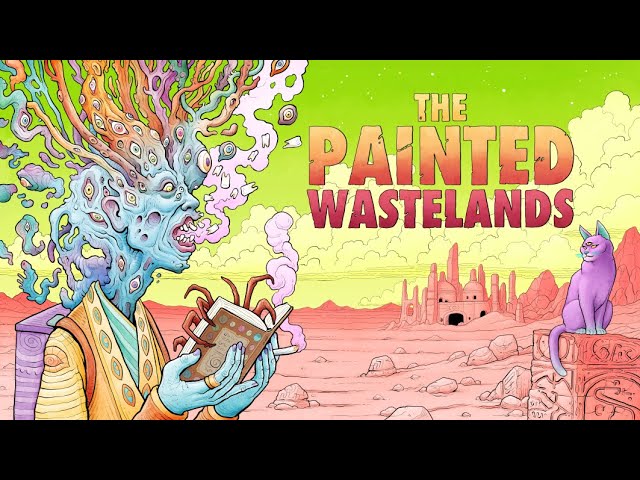If regular Dungeons and Dragons is just a bit too predictable, safe, and square for your tastes, may I recommend The Painted Wastelands? Written by Chris Willett and illustrated by Tim Molloy, this hex-crawl mini-setting has an atmosphere that’s halfway between the Outlands in Planescape and the Hitchhiker’s Guide to the Galaxy, carried by vibes that are equal parts Star Wars and Fear and Loathing in Las Vegas.
I received a free sample of The Painted Wastelands from the authors; it’s a 148 page full color hardback, and designed for use with Old School Essentials and other RPGs inspired by early editions of Dungeons and Dragons. I’ve only run one test session with it so far, so these are just my early impressions, not a full review – but I wouldn’t be writing anything if I and my players hadn’t had a great time.

The Painted Wastelands is available now from DriveThruRPG as a PDF, or in physical form from publisher Agamenon Press. The team also has a Kickstarter in the works that will expand the setting with a Player’s handbook and a Zine that adds extra adventure locations.
The first thing you’ll notice about The Painted Wastelands is the incredible art. That was actually the start of the whole project: writer Willett first asked artist Molloy if he could make an RPG adventure based around his unique psychedelic artwork. Little did he know that Molloy’s dreamy, out-there illustrations were actually connected into an original fantasy setting, the Upper and Lower Ethereal Hierarchies.
The Painted Wasteland details one corner of this weirdo cosmology. It’s a desert split into 35 hexes, packed with encounters that include dive bars, sniper stand-offs, a rave in a dungeon, and a never-ending gig in a pocket dimension locked outside of time, to pick a few. There’s a never-ending pilgrimage circling the whole thing, with travellers carrying holy mummies and renting unreliable second-hand jetbikes.
Cosmologically, the Ethereal Hierarchies are some kind of astral plane. Not the ‘sparkly mists and floating god corpses’ sort that you hack across in DnD Spelljammer – the kind of astral plane you reach on an ayahuasca retreat, or stumble into while out of your gourd on psychedelics on day three of a festival.
There are several ways for player characters to end up here, but I simply ripped my player party out of their main campaign and dumped them in the starting hex with a bad hangover.
Dream logic runs throughout the setting. Inhabitants of the Painted Wasteland talk in dreamspeak, and low level characters have only a 40% chance of being able to understand more than one word in two that they say. Travel between hexes is also chancy – the logic of dreams means there’s a good chance that the party will make no progress at all, or overshoot, or have an oddball encounter on the way.
I went absolutely ham giving unique verbal treatments to each new NPC that the players couldn’t understand, pulling from every audio oddity I’d ever experienced in a dream or encountered in a David Lynch movie. Not that the book asked for it – it was just too fun not to. That’s exemplary of how I found the book – packed with inspirational ideas, light on prescriptions about how to use them.
Despite literally dumping the players in the centre of the map at the start of the adventure, there are some well considered guard rails to give the player experience some structure.
Several early encounters will give players information about a sorcerer’s market – think Mos Eisley, but with way more stoners – to guide them towards a safe hub. Several plot hooks for adventures, valuable treasures and unique boons to be won in the setting, and factions to court or fight, can give a campaign an overarching structure.
Personally, I think the vibes are immaculate. The Painted Wastelands are a realm of nomads and truckers, dungeons that are marketed as escape rooms, currency you can smoke, meditation pyramids that emit drugs, bleeding-eye cultists, and – of course – a talking skull companion. Loot might include sought-after band t-shirts or limited edition tie-in movie merchandise, and every night the party will have the latest episode of an interdimensional telenovela broadcast into their brains.
The book is packed with workable suggestions, but you’ll need to improv some to connect things together. I like that, but it doesn’t offer the substantive and grounded descriptions of things, people, and places in modern DnD books, if those are what you’re into.
Despite being designed for Old School Essentials, The Painted Wasteland will work for any RPG based on old DnD editions, particularly the versions where ‘elves’ and ‘dwarfs’ were classes, not DnD races. Speaking of which, there are a couple of original DnD classes in here too: the dream magic Oneiromancer, and the Cat. Not Catfolk, or Leonine, or Tabaxi – just a Cat. They can have a pet human to carry them, too.
If you’re a bit burnt out on the mainline DnD release schedule, but still want to play RPGs with a core of dungeoneering and treasure seeking, The Painted Wastelands is a great example of what indie designers are doing with OSR (old school renaissance) style games. But if you do want a complete break from everything involving either Dungeons OR Dragons, our guide to the best tabletop RPGs has you covered!
Source: Wargamer




